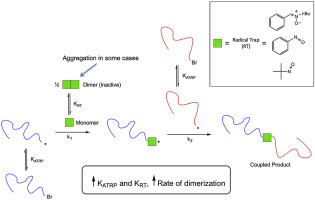Polymer ( IF 4.6 ) Pub Date : 2017-08-23 , DOI: 10.1016/j.polymer.2017.08.046 Jessica P. Wu , Ching W. Pan , Katherine E. Heiler , Megan E. Ching , Eric S. Tillman

|
Atom transfer radical coupling (ATRC) reactions assisted by radical traps were studied under various conditions, with the extent of coupling of polymer chains monitored as a function of time. When using a radical trap that tended to aggregate into dimers, such as 2-methyl-2-nitrosopropane (MNP), the rate of coupling was enhanced when conditions were adjusted to favor its de-aggregation to the monomeric form: less polar solvent mixtures and/or the addition of β-cyclodextrin (β-CD). With radical traps that did not aggregate, such as nitrosobenzene (NBz) and N-tert-Butyl-α-phenylnitrone (tBuPN), coupling was generally accelerated under conditions consistent with higher KATRP values. MALDI-TOF analysis was used to confirm the incorporation of the radical trap into the polymer dimers, supporting the mechanistic pathway proposed for radical trap-assisted ATRC. The effect of aggregation of the radical trap was further probed by using fractional equivalents of NBz in the coupling reaction, with a full equivalent leading to end-capped polymer chains that were unable to dimerize. By reducing the equivalents of NBz, the extent of coupling could be controlled by the temperature, with higher temperatures (80 °C) allowing ATRC to compete with RTA-ATRC and higher extents of coupling were observed.
中文翻译:

改变自由基陷阱在聚合物链的原子转移自由基偶联反应中的有效性
在各种条件下研究了由自由基陷阱辅助的原子转移自由基偶联(ATRC)反应,并根据时间监测了聚合物链的偶联程度。当使用倾向于聚集成二聚体的自由基阱时,例如2-甲基-2-亚硝基丙烷(MNP),当调节条件以使其解聚为单体形式时,偶联速率会提高:极性较小的溶剂混合物和/或添加β-环糊精(β-CD)。与没有聚合自由基捕获剂,如亚硝基苯(NBZ)和ñ -叔丁基- α苯基硝酮(tBuPN),偶联通常与较高的K相一致的条件下加速ATRP价值观。MALDI-TOF分析用于确认将自由基陷阱引入到聚合物二聚体中,从而支持了针对自由基陷阱辅助ATRC提出的机理途径。通过在偶联反应中使用分数当量的NBz进一步探究自由基陷阱的聚集效应,完全当量导致末端封端的聚合物链无法二聚。通过降低NBz的当量,可以通过温度控制偶联程度,较高的温度(80°C)使ATRC与RTA-ATRC竞争,并且观察到偶联程度更高。



























 京公网安备 11010802027423号
京公网安备 11010802027423号